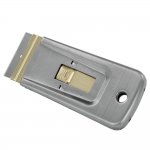Bill B
New member
- Joined
- Jan 3, 2011
- Messages
- 171
- Reaction score
- 1
- Points
- 0
- Age
- 53
- Location
- Grand Rapids, Michigan
- Country
- United States
- Display Name
- amphibianizer
Hi all --
I have aquarium that previously I had used essentially as a terrarium with a false floor. I took off what used to to be the false floor (I personally use egg crating (not really anything to do with eggs - that's just what it is called) with window screen) and now still have a strip of silicone sealant/caulking I had used to try to keep the false floor in place and prevent any amphibs from getting too far down, possibly below the false floor, where they might be trapped.
I went to some pages on the internet, and I'm not seeing answers that I can personally use that much. One page suggested using something called Xenit (not even available around here, as far as I know). Another suggested using a heat using a hair drying. I don't want to buy hair dryer. If it is necessary, I will, but I'm looking for other options.
Bil
I have aquarium that previously I had used essentially as a terrarium with a false floor. I took off what used to to be the false floor (I personally use egg crating (not really anything to do with eggs - that's just what it is called) with window screen) and now still have a strip of silicone sealant/caulking I had used to try to keep the false floor in place and prevent any amphibs from getting too far down, possibly below the false floor, where they might be trapped.
I went to some pages on the internet, and I'm not seeing answers that I can personally use that much. One page suggested using something called Xenit (not even available around here, as far as I know). Another suggested using a heat using a hair drying. I don't want to buy hair dryer. If it is necessary, I will, but I'm looking for other options.
Bil


